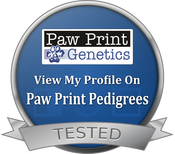Genetic Testing
For a Labrador Retriever, look for at minimum the following clearances as recommended by the Canine Health Information Center (CHIC). Genetic testing is an intricate part of our breeding program. Genetic testing is the only way to identify whether every Labrador in our breeding program is free of genetic diseases. This kind of testing can provide advantages over traditional techniques such as pedigree analysis and help breeders to develop proactive, sustainable breeding programs. Additionally, disease test results are accepted by the Orthopedic Foundation for Animals (OFA) for Canine Health Information Center (CHIC).
As a puppy buyer: You want a puppy that will lead a long, healthy life you want to ensure the puppy's parents are not affected by the most common diseases of the breed. The only way to ensure the parent's are not affected is for them to have health clearances for these common diseases
For genetic diseases a dog is rated: clear, carrier, or affected.
"Clear" means the dog posses no copies of the mutant gene for a disease; it will never have the disease or pass the disease on to its offspring.
"Carrier" means the dog posses one copy of the mutant gene and one copy of the normal gene; the dog does not have and will not develop the disease; it should be bred only to dogs "Clear" of the same disease to prevent producing dogs affected by the disease; if bred to another "Carrier" 25% of the puppies will be expected to be affected by the disease, 50% of the puppies will be "Carriers"; if bred to an "Affected" dog, 50% of the puppies will be expected to be affected by the diseases and 50% "Carriers."
"Affected" means the dog posses two copies of the mutant gene; it will have the disease/ be affected by the disease in its lifetime. "Affected" dogs should only be bred to "Clear" dog's to ensure they produce no "Affected" dogs, but all puppies produced in such a mating would be "Carriers" of the disease. If bred to a "Carrier" or "Affected" dog of the same disease, "Affected" puppies will be produced.
Dogs/Puppies can be considered "clear by parentage" for genetic diseases (EIC, CNM, PRA-prcd, RD/OSD, cystinuria, DM) if both parents were "clear" for a genetic disease.
As a puppy buyer: You want a puppy that will lead a long, healthy life you want to ensure the puppy's parents are not affected by the most common diseases of the breed. The only way to ensure the parent's are not affected is for them to have health clearances for these common diseases
For genetic diseases a dog is rated: clear, carrier, or affected.
"Clear" means the dog posses no copies of the mutant gene for a disease; it will never have the disease or pass the disease on to its offspring.
"Carrier" means the dog posses one copy of the mutant gene and one copy of the normal gene; the dog does not have and will not develop the disease; it should be bred only to dogs "Clear" of the same disease to prevent producing dogs affected by the disease; if bred to another "Carrier" 25% of the puppies will be expected to be affected by the disease, 50% of the puppies will be "Carriers"; if bred to an "Affected" dog, 50% of the puppies will be expected to be affected by the diseases and 50% "Carriers."
"Affected" means the dog posses two copies of the mutant gene; it will have the disease/ be affected by the disease in its lifetime. "Affected" dogs should only be bred to "Clear" dog's to ensure they produce no "Affected" dogs, but all puppies produced in such a mating would be "Carriers" of the disease. If bred to a "Carrier" or "Affected" dog of the same disease, "Affected" puppies will be produced.
Dogs/Puppies can be considered "clear by parentage" for genetic diseases (EIC, CNM, PRA-prcd, RD/OSD, cystinuria, DM) if both parents were "clear" for a genetic disease.
OFA Hips: This tests for hip dysplasia. Hip dysplasia is a condition which causes abnormal changes to the hip joint, often causing lameness and pain. Hip dysplasia can be mild enough that the dog shows no lameness or can be so severe the dog limps and requires medications to control pain. Hip evaluations should be done for every breeding dog. Just because a dog's parents have hip clearances doesn't mean that dog does not have hip dysplasia. Dogs cannot be "normal/good by parentage" for hips. Hip evaluations determine if a dog's hips are normal or dysplastic. Normal/Passing OFA hip scores are Excellent, Good, and Fair. Only dogs with passing OFA hip scores should be bred. Failing OFA hip scores are: Borderline, Mild, Moderate, and Severe.
PENN Hip: PennHIP is a multifaceted radiographic screening method for hip evaluation. The technique assesses the quality of the canine hip and quantitatively measures canine hip joint laxity. The PennHIP method of evaluation is more accurate than OFA which is the current standard in its ability to predict the onset of osteoarthritis
OFA Elbows: This tests for elbow dysplasia. There are various types and severity of elbow dysplasias, all of which can cause lameness of varying degrees. Dogs who pass an OFA elbow evaluation are rated Normal. All other ratings are dysplastic. Dogs with elbow dysplasia can lead fairly normal life never showing lameness; however some will be severely lame and may worsen as they age. Dogs cannot be "normal/good by parentage" for elbows.
Progressive Retinal Atrophy, Progressive Rod-Cone Degeneration (PRA-prcd c.5G>A) causes degeneration of both rod and cone photoreceptor cells of the retina. Affected dogs initially experience night blindness and loss of peripheral vision around 3-5 years of age. As it progresses, complete blindness will occur.
CNM (Centronuclear Myopathy): This is a genetic progressive muscle disease. Symptoms vary in severity in each dog, but do progress. Symptoms include muscle weakness, difficulty walking, and complications leading to respiratory problems. Dogs are classified as CNM clear, carrier of affected. Clear and carrier dogs will never show symptoms. Affected dogs will have symptoms.
Canine Degenerative Myelopathy (DM) is a devastating degenerative disease of the spinal cord that can progress rapidly and cause weakness in the hind limbs and eventually paraplegia among genotypically affected dogs.
Macular Corneal Dystrophy: MCD is an inherited eye disease that causes problems with a dog's sight. In affected dogs, a build-up of carbohydrate causes the surface of the eye (the cornea) to become cloudy.
Dilute: This is a genetic component of coat color. The stance of the Labrador Retriever Club (the AKC parent club, which determines the breed standard) is that dogs carrying or expressing the dilute gene are not purebred Labrador Retrievers. Dogs are classified as clear, carrier, or affected. Carrier dogs will be of normal coat color, but can produce affected puppies if bred to another carrier or affected dog. Affected dogs will exhibit a different coat color and pigment, especially noticeable in "silver" and "charcoal," while the "champagne" is less prominent.
Cardiac: A dog will undergo an examination of the heart to look for congenital cardiac defects. Dogs are given a passing or non-passing score; non-passing includes grades of severity of cardiac murmurs from Grade 1 to 6. Triscupid Valve Dysplasia (TVD) is the most common cardiac problem in Labradors. The AKC Canine Health Foundation now recommends an echocardiogram be performed on all breeding stock Labradors to identify the presence of TVD. "The most definitive method of diagnosis is an echocardiogram."


